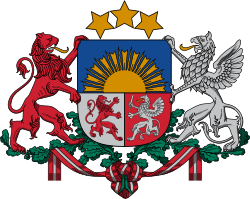First Saeima of the Republic of Latvia 1. Latvijas Republikas Saeima | |
|---|---|
| History | |
| Preceded by | Constitutional Assembly of Latvia |
| Succeeded by | 2nd Saeima |
| Leadership | |
Frīdrihs Vesmanis (until 17 March 1925) Pauls Kalniņš (from 20 March 1925) | |
| Structure | |
 | |
 |
|---|
| History of Latvia |
|---|
 |
| Chronology |
The 1st Saeima was the parliament of Latvia from 7 November 1922 until 2 November 1925. It was the first Saeima to be elected after the Constitutional Assembly of Latvia had created the Constitution of Latvia and the Elections Law.
Contents
Social-Democrat Frīdrihs Vesmanis was Speaker of the Saeima until 17 March 1925 followed by Social Democrat Pauls Kalniņš.
The 1st Saeima gave confidence to the 1st cabinet of Zigfrīds Anna Meierovics (20 July 1922 – 26 January 1923), cabinet of Jānis Pauļuks (27 January 1923 – 27 June 1923), 2nd cabinet of Meierovics (28 June 1923 – 26 January 1924), cabinet of Voldemārs Zāmuēls (25 January 1924 – 17 December 1924) and the 1st cabinet of Hugo Celmiņš (19 December 1924 – 23 December 1925).